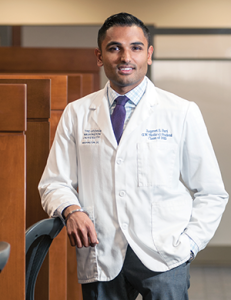When Jaspreet Suri arrived in Southern California as a 7-year-old in 1995, among his earliest experiences was a broken leg during school. Natives of New Delhi, India, Suri’s parents had only recently moved him and his sister to Los Angeles in search of a better environment — one more conducive to raising children and ensuring their future success. He recalls running in gym class when his femur suddenly snapped before his leg even hit the ground. “I also remember walking home from school and breaking my femur bone again,” says Suri, explaining that he has broken the same two bones, his left and right femurs, multiple times.

It wasn’t until his fourth break, at age 11, that Suri was diagnosed with a mild form of osteogenesis imperfecta (OI), a rare genetic disorder characterized by brittle, easily breakable bones. The National Institute of Arthritis and Musculoskeletal and Skin Diseases estimates that roughly 20,000 people, and perhaps as many as 50,000, live with this disorder in the United States.
Since then, Suri, who earned his bachelor’s degree in physiological science from the University of California, Los Angeles, has undergone countless surgeries to realign his bones and strengthen them with rods. “I have metal in both femurs right now,” he says, which is why his bones are no longer breaking.
As a child, Suri notes, his experiences with doctors weren’t always positive. “Just because a patient is young doesn’t mean you should belittle their concerns and brush them aside,” he says. “You still have to treat them with the same level of respect as if you were treating an adult.”
Living with OI inspired Suri, now a fourth-year medical student at the George Washington University School of Medicine and Health Sciences, to pursue a career in medicine and ensure that people with similar health problems are treated with empathy and respect.
“Growing up in a close-knit family, I wanted the opportunity to be on my own and foster my personal growth,” he says. Leaving the West Coast for GW offered Suri that sense of independence he craved, as well as limitless professional opportunities. “Being at GW has given me the chance to attend national conferences, attend health policy talks, and listen to politicians speak — experiences that are harder to come by in Los Angeles.”
As the current senior class president, Suri sees a leadership role in medicine in his future. “Starting off as a clerkship director [and then going from] program director to one day becoming chair of a department of medicine is a goal of mine,” says Suri, who officially became a U.S. citizen during his second year of medical school. “I thought this would be a good place to start because it gives me firsthand experience in policy and decision making.”
Suri manages his medical condition by maintaining a healthy lifestyle and limiting the amount of stress he puts on his bones. Sadly, this means he can’t play contact sports such as soccer or basketball anymore, things he enjoyed as a child.
“At the end of the day, I just want to be a brilliant clinician,” says Suri. “One who is liked by my patients, respected by my colleagues, and looked up to by the next generation of medical students.”



